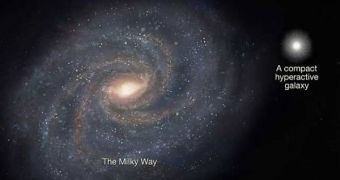Scientists gained the ability to peer way back into the Universe's history some time ago, but some of the discoveries they made were not exactly in tune with some of the theories that were developed to explain astronomical phenomena today. In a recent such find, distant stars, estimated to be about 11 billion light-years away, in the early Universe, were discovered to travel at about 1 million miles per hour, about twice faster than our own Sun moves through the Milky Way.
The study is so important because it adds more substance to previous finds, which showed a peculiar trend among early galaxies. According to astronomers, the youngest and most massive new galaxies that were formed within 2 to 3 billion years after the Big Bang were very heavy, yet extremely compact and hyperactive. The reason why these galaxies were on average about five times smaller than the same type as today has thus far eluded scientific understanding.
“A lot of people were thinking we had overestimated these masses in the past. But this confirms they are extremely massive for their size. These galaxies are indeed as bizarre as we thought they were,” says of the new study its leader, Pieter van Dokkum, who is an astronomer at the Yale University. For the new investigation, his team focused on a galaxy designated as 1255-0, which was analyzed using both the Hubble Space Telescope and the Gemini South observatory, in Chile. The main idea that led to the assessment of the galactic masses was the speed of the stars.
For example, back in our own solar system, the speed at which Earth revolves around the Sun is dictated by the star's gravitational pull, and therefore its mass. And seeing that the team found no black hole as a source of this amazing hyperactivity, they assumed that all acceleration was based on the mass of the compact, early galaxies. Then, they used the speed of the star to calculate the galactic weight.
What is even more peculiar, van Dokkum reveals, is the fact that these galaxies seem to grow over billions of years but not necessarily in mass. That is to say, they spread out throughout the Universe, and expand until they reach the size of the Milky Way but they do not add mass considerably. “It's a bit of a puzzle. We think these galaxies must grow through collisions with other galaxies. The weird thing is that these mergers must lead to galaxies that are larger in size but not much more massive. We need a mechanism that grows them in size but not in mass,” the expert is quoted as saying by Space.

 14 DAY TRIAL //
14 DAY TRIAL //